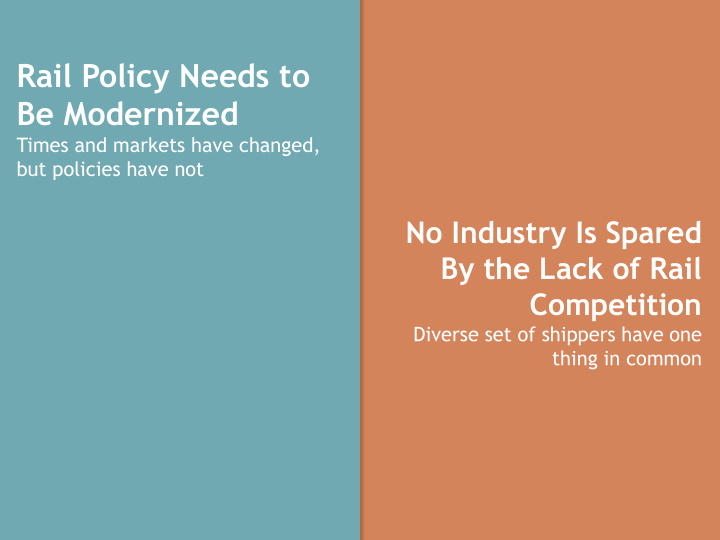



Rail Policy Needs to Be Modernized Times and markets have changed, but policies have not No Industry Is Spared By the Lack of Rail Competition Diverse set of shippers have one thing in common
Times and Markets Have Changed; Policies Have Not 1980: Policy Goals 2013: Time to Reassess Strengthen Railroad Finances Railroads are Financially Sustainable Provide Quick Dispute Resolutions Disputes Costly and Time Consuming Ensure Effective Competition Policies Prevent Shippers from Wherever Possible Competitive Access and Reasonable Rates Maintain Reasonable Rates Even Rail Mergers Significantly Reduced Without Effective Competition Competition and Rates Soared “The goal of the Staggers Acts was not to enrich railroad companies, but to ‘provide a regulatory process that balances the needs of carriers, shippers, and the public .’ [Policymakers] will need to carefully consider whether changes are needed to reach this goal .” - Senate Committee on Commerce, Science, and Transportation; 2013
What We Already Know
Most Shippers Lack Competitive Rail Service 78% of freight rail stations are captive by a single Class I railroad. In every state, the majority of rail stations are now captive to a Class I railroad. Source : Analysis of Freight Rail Rates for Chemical Shippers ; Escalation Consultants; 2012
New Research Shows the Freight Rail Problem is Getting Worse
Analysis of Freight Rates for All Commodities Escalation Consultants studied STB’s Public Use Waybill Sample for all Non - Intermodal U.S. rail traffic and calculated railroad revenues and variable costs for all commodities in 2005 and 2011. The analysis calculated the ‘premium’ for non -competitive rates (above 180% RVC). Rates greater than 180% RVC are subject to potential STB review. Premium = (avg. rate above 180% RVC – avg. rate below 180% RVC) X total carloads with rates above 180% RVC
2011 Premium on Non-Competitive Shipments $4,000 $3,500 $1,335 per car $3,000 In effect, a 53% premium $2,500 $2,000 $1,500 $1,000 $500 $- Average Non- Average Competitive Rate Competitive Rate
Premium by RVC Range (2011) Total premium is $16.2 billion, with most coming from rates above 300% RVC RVC Range % of Total Premium for Rates Carloads above 180% RVC 180-240 22% $2.9 Billion 241-299 12% $3.1 Billion >300 23% $10.2 Billion Total 57% $16.2 Billion
Railroad Pricing Power – Not Demand or Costs – Is Driving Rates Higher What other industry can get away with charging much higher prices even as demand drops? 100% 90% 90% 80% The Common 70% 60% Sense Gap 50% Competitive 40% markets simply do 30% not work like this 20% -1% 10% 0% -10% Change in Carload Volume Change in Rate Premium (2005 - 2011) (2005 - 2011)
Premium By Commodity (2011) Carloads Premium for Rates Above Description >180% RVC 180% RVC Coal 56% $5.2 Billion Chemicals or Allied Products 77% $4.5 Billion Transportation Equipment 37% $1.2 Billion Food & Kindred Products 42% $763 Million Nonmetallic Minerals Except Fuels 66% $750 Million Petroleum or Coal Products 70% $659 Million Clay, Concrete, Glass or Stone Products 75% $605 Million Primary Metal Products 64% $597 Million Farm Products 52% $558 Million Pulp, Paper or Allied Products 43% $449 Million
Questions
Recommend
More recommend